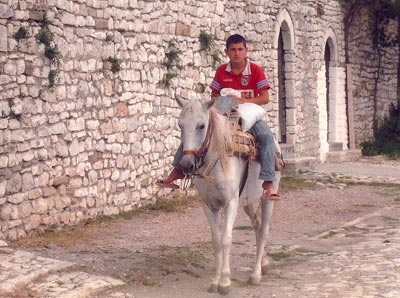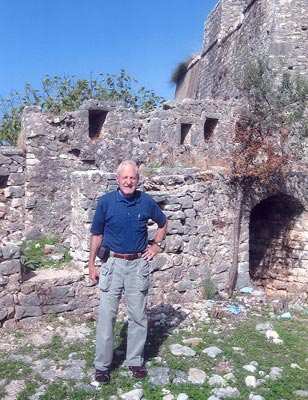Discovering Albania
by Edward Lifset, Oceanside, CA
Along with five other well-traveled adventurers, I took an all-encompassing trip to Albania in September ’07 offered by Original World (Mill Valley, CA; 888/367-6147, www.originalworld.com). Reasonably priced at $1,560, exclusive of international air and single supplement, the 12-day tour featured a very complete and active itinerary plus nine different, well-located small hotels and inns with a great deal of local color.
We were fortunate to have had the services of an outstanding young guide who was a full-time graduate student and a university instructor in contemporary Albanian history and politics. Our driver, who had previously been selected to drive in President Bush’s entourage during the latter’s recent visit, provided his personal Mercedes-Benz van for our convenience. These gentlemen cheerfully provided every service requested by group members.
The tour covered every major city and town in the country, and each day was filled with planned visits and activities plus a few extras. The activity level was relatively brisk.
The exodus
In order to better appreciate a visit to Albania, one should possess at least a minimal understanding of its unique history, culture and geography as well as a little knowledge about the country’s key leaders.
Albania is one of the smallest countries in Europe and the youngest as well, having gained its independence from the Ottoman Empire in 1912. In the first 30 years of its existence, it was invaded by all of its neighbors. The regime that took over in 1944 used a combination of terror, nationalism and isolation to retain power until long after most other Communist governments had fallen.
Civil unrest overwhelmed the country in 1991-92 and 1997. After a few years of democracy, the economy was in shambles, resulting in an exodus of educated and middle-class Albanians looking for a better life in Europe and America.
Tirana and Kruja
My eventful trip commenced as I landed at Mother Teresa International Airport in Tirana. (Mother Teresa was born an ethnic Albanian in what is now Macedonia.)
After dealing with passport formalities, I was transported to a small hotel, actually a converted Italian-style villa complete with a balcony and a garden restaurant but no elevator. The hotel was located only a few hundred meters from Skanderbeg Square, the city center, so I was able to walk there, change money and photograph the old Cameria Mosque and clock tower, the Palace of Culture, the Anthropological Museum, the National Theater and several impressive government buildings.
From Tirana we traveled to Kruja, perched high on the face of a hill. Kruja was the center of resistance against the Ottoman Turks under the leadership of Albania’s national hero, Skanderbeg, who held the Turks at bay for over 30 years.
We visited the fortress of Kruja, the small but impressive Skanderbeg Museum, an ethnological museum and a large but nearly empty bazaar featuring antiques, local handicrafts and silver jewelry.
Later that day we arrived in Durrës on the central coast. This ancient city was founded as Epidamnos in the seventh century B.C. and was the capital of Albania for a few years after its independence. We visited many Illyrian, Greek, Roman, Byzantine, Venetian and Turkish ruins there as well as a fine anthropological museum. The main attractions were the huge, second-century Roman amphitheater and Old City walls.
Ancient sites
We left Durrës for Elbasan, passing through the Krraba Mountains and a beautiful run of fantastic bleak and wild scenery. Elbasan had its origins in the second century as a trading post and protective fortress on the junction of the Roman road to Byzantium and the road from the Albanian coast.
The Turks rebuilt the walls and used the fortress as a base for extending their conquest. Within the surviving walls, we visited the King’s Mosque. Dating from around 1492, it is one of the oldest in Albania.
We proceeded to Pogradec, located on the shores of Lake Ohrid on the border with Macedonia. The lake itself is almost 300 meters deep in parts and is home to several unique species of fish.
A few of the travelers in our group would have liked to have spent at least one night on the Macedonian side of the lake, as it is more built up and there would have been a little more of interest there.
The following day we drove south to Korça, one of the main centers of Albanian resistance. Korça was twice captured by Greece and for a while was an independent republic protected by France.
Here we visited the Museum of Medieval Arts, which has the largest collection of icons and religious artifacts in Albania, with over 7,500 objects spanning 16 centuries.
Of particular interest was the Mirahori Mosque, built in the late 15th century and reputed to be the oldest in the country. We visited with the imam and were able to photograph activities inside.
On this day we also visited Voskopoja, which, with a population of over 3,500, was the largest city in the Balkans in the early 18th century, surpassing Sophia and Athens. The first printing house in the Balkans was located there, as were 24 churches plus a basilica in each quarter.
We visited the Church of St. Nicholas, which houses many famous frescoes done by noted Albanian artists. An interesting local market was located directly across from our hotel.
After an early breakfast, we left for the UNESCO World Heritage Site and museum city of Gjirokastra. It is the birthplace of dictator Enver Hoxha, who ruled Albania for 41 years; his birthplace has been converted into an ethnographic museum.
We visited the castle, perched high above the city, and the Blue Eye, an unusual underwater spring located 15 minutes off the main road going toward Saranda. The spring is over 50 meters deep and has not been fully explored. The water bubbles up through a deep pool, making an odd circular shape, deep blue at its center and almost an electric blue green on the edges. This pretty spot has mossy old oak trees and wildflowers around it.
Our inn for the night was a restored old Ottoman-style home on a narrow cobblestone street.
Saranda
En route to Saranda, on the south coast, we stopped at the 12th-century Mesopotam Church and the adjoining Greek cemetery. The church was in a bad state of repair, but its high cupolas, lovely carved dragons and animal mosaics could still be admired.
Saranda has one of the loveliest settings in Albania. Its bay forms a horseshoe, and whitewashed houses climb the slopes. The climate is mild and the sun shines about 290 days each year. The Greek island of Corfu is just a few miles across the bay.
Visitors to Albania stop at Saranda for at least one day, primarily to visit the nearby Roman ruins of Butrint. We spent an afternoon at Butrint, about a 40-minute drive from Saranda. This is Albania’s most important archaeological excavation site and perhaps one of the most important sites in the whole Mediterranean area. Butrint was indeed one of the highlights of the entire trip.
Dinner that night was at Lekursi Castle. From that vantage point we could see the sparkling lights of the city, the Bay of Saranda and the island of Corfu.
The following day, we were free to relax and enjoy Saranda and its surroundings. Two of our group elected to take the ferry to Corfu for the day to tour the island, including the old town, villages, a huge Venetian fortress and olive groves. The island was bustling, especially the shops, restaurants and beaches. I highly recommend this extra on the one free day of the tour.
Continuing along the coast
An early departure took us north for several hours on the Albanian Riviera toward the coastal city of Vlora, where important events in the struggle for Albanian independence took place. The roads were full of “S” and hairpin turns, but our driver was excellent and the drive extremely scenic.
We had a lunch of grilled lamb, Greek salad and unique Albanian morsels in a mountain home several miles off the main road, then hiked to an old Ottoman bridge which we traversed on foot to espy villages accessible otherwise only by donkey.
In Vlora, we visited the Independence Museum and received a tour of the house and a briefing on the politics involved there. This house was kept just as it was in 1912 when the seeds of independence sprouted.
Early the following morning we headed north on a very scenic and winding road to the ruined Corinthian city of Apollonia, founded around 600 B.C. Then an important port, it lost its importance when the river shifted its course, and it now stands forlorn on a hilltop overlooking the fertile Muzeqe plain.
We looked at a selection of finds from Apollonia at a nearby 13th-century Byzantine church and monastery. Monks no longer occupy the monastery, but it’s a base for archaeological work. Since our guide had previously worked there as a researcher, we received a great deal of detail about this interesting site, one of the finest in the Mediterranean.
From Apollonia, we drove north and then southeast to the beautiful museum town of Berat, one of the oldest cities in Albania and one of the most attractive. Its white houses climbing the hillside toward the well-preserved citadel is one of the best-known images of Albania.
Within the citadel are many Orthodox churches, most notable of which is the Church of St. Mary’s, which houses an outstanding collection of icons painted by a 16th-century master. This city is considered a “must see” for all visitors to Albania.
Shkodra
The next day we proceeded to Shkodra, the most important town in northern Albania. During the Ottoman occupation, Shkodra served as the seat of a semiautonomous area which stretched into what is now Kosovo. Italian influence was noticeable there, as the city was part of the Venetian Republic for over 100 years, ending in 1479.
The main attraction in Shkodra is Rozafa Castle, which stands at the confluence of three rivers and controls all but the northern approach to the city. Although it was originally constructed during Dlyrian times, most of what remains is Venetian or medieval. The views across the lake to Montenegro, out toward the Adriatic Sea and down toward Lezha are fantastic.
We hiked through vaults, tunnels, three courtyards, defensive systems, churches and a mosque. We later visited the Marubi Museum, which contained an exhibition of old photographic prints, the oldest taken in 1856 — authentic depictions of life from 150 years ago.
The journey ends
The following day we drove back to Tirana and visited many of the points of interest we didn’t have time to see on our first day. We also visited two master artists, one a master copper craftsman, the other a master painter. The afternoon was free for shopping, taking photos and just appreciating the city.
This trip was a great eye-opener for me. It afforded an in-depth view of a country about which I previously had only sparse knowledge. We covered every item in the activity-packed itinerary plus a few extras offered by our guide and driver. I had no idea of what to look forward to before I left on this jaunt, but it surpassed all of my expectations.
Barbara Sansone, the owner and manager of Original World, was polite, informative and did a great job as far as pre-trip information was concerned. In fact, she provided much information that I had not even requested.
The owners of the local operator, Albanian Holidays, attended our final dinner and we were able to give them useful feedback.
I heartily recommend this specific trip to anyone who is even mildly interested in the Balkan area and, specifically, Albania.





